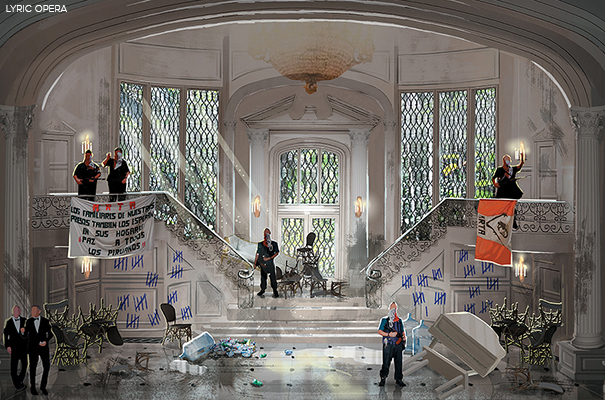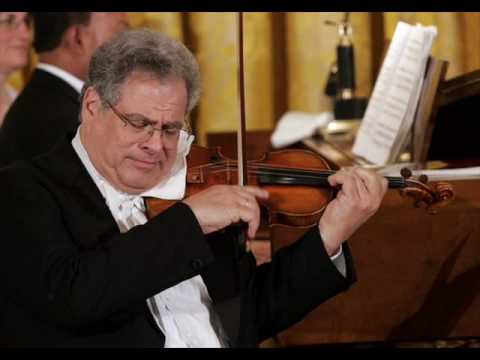Music review: Chicago Lyric Opera's Bel Canto
December 15, 2015 • 14 Comments • Posted in blindness, technology for people who are blind, UncategorizedThe biggest surprise in last Thursday’s performance of Bel Canto at Chicago’s Lyric Opera came in the second act. and it didn’t happen on stage.
I wrote a post last week about preparing to see (okay, hear) my first live opera.
- I reread the book Bel Canto.
- I heard the book’s author Ann Patchett talk with Renee Fleming at a Lyric Unlimited presentation about transforming a novel into an opera.
- I attended a panel discussion by the Bel Canto composer, librettist, director and conductor about the work involved in developing a new opera.
- I used my talking computer to study the word version of the playbill (thank you, Lyric Opera of Chicago, for emailing that to me ahead of time).
- I convinced a friend to accompany me to the opera Bel Canto Thursday.

A scene from Bel Canto.
As far as that last bullet point goes, I must say, it hardly took convincing. My friend Jenny Foucré Fischer is a musician herself (flute) and met her husband Dean (French horn) when we were all in the York Community High School band together. Dean and Jenny Fischer raised three talented children. All three play musical instruments. Jenny attended operas with them when they were growing up, and, like me, she loved the book Bel Canto. Jenny has worked at The Bookstore in Glen Ellyn for 17 years and is, by definition, a book nerd. Want proof? When I told Jenny that Mike and I often listen to an audio book in bed together to help us fall asleep, she responded, “That’s my idea of foreplay!”
Neither Jenny nor I wore ballgowns to the opera house, but we did dress up some –- she wore a glittery sweater, and I went for the tuxedo look: black wool slacks with a long white button-down classic shirt. We arrived early for yet another preview discussion, this one about the score.
Composer Jimmy Lopez is originally from Peru, where the opera is set, and the presenter we heard before the opera gave us specific scenes (“he’d say stuff like “In Act One, Scene Two” for example) where Lopez has a huge conch shell in his instrumentation. “It will sound like a horn, but a horn you may never have heard before.” He told us which scene would feature cellists plunking strings rather than using their bows, and how the composer brought whistles from Peru to depict the sounds of birds in one scene. The ability to read the playbill ahead of time was extremely helpful. I could imagine where the bird sounds might be used and looked forward to hearing them.
He acknowledged that many in the audience were probably here because we liked the book Bel Canto so much. “Raise your hand if this is your first time at an opera.” My hand shot up, and I sensed Jenny turning around to count how many hands were up behind us. About a third of the audience was in my boat.
When the presenter advised us not to compare the book with the opera, I recalled Ann Patchett saying in conversation with Renee Fleming weeks earlier that she was perfectly happy to hand her novel over to Lyric and allow the creative team to do anything they wanted with it. “I’ve read the libretto,” she said. “And, really, it’s better than the book.”
The presenter at the opera said he was confident we’d go home later tonight loving both, and then, presentation over, Jenny led me out to the lobby and treated us each to a glass of wine before the show. I went on so much about the opera that I didn’t have time to finish my wine. Tant pis.
We were settled in our seats when Lyric’s Facility Operations Manager Nora O’Malley tapped me on the shoulder. “You want a headset?” We were there the night of Lyric’s accessible performance. Nora explained that a sighted narrator was in the balcony to translate subtitles and describe visual effects into an earphone I could wear. The earpiece would just be in one ear so I could listen to the music with the other.
I’ve tried these headsets at plays, and sometimes the person talking in my ear distracts too much from what’s going on onstage. But this was different. The panel discussion I’d been to a week earlier clued me in that Bel Canto would be sung in nine, count them, nine, different languages. I nodded yes.
The small rectangular receiver Nora placed in my palm felt familiar. I immediately knew how to work the dial. “It’s a Steppenwolf device,” she said. Sure enough, I’d used this same device at Steppenwolf Theatre a year or so earlier, and then again last month at a Straw Dog Theatre production featuring puppetry. When the Straw Dog staff offered me a headset, they, too, described it as a “Steppenwolf device.” It’s not a brand name. It’s a nod to Steppenwolf Theatre for spearheading efforts to make Chicago cultural events more accessible. Steppenwolf is generous with their accessible equipment — they loan it out to a lot of Chicago organizations offering audio description.
But on with the opera. The presenter of the preview talk that night mentioned that the opera would begin with the chorus singing about how delighted they were to be in Peru. “Listen for hints of that same melody at the end of the opera,” he said. I kept my headset off for the opening. I didn’t need to know the words, I already knew they were happy to be in Peru. I just wanted to take in the music and keep my ears open for the conch.
Throughout the first act I’d put the earphone in my left ear, dial up the volume for short bits of dialoguelibretta and turn the volume off and take the earphone off for the more orchestral bits. At times the music was so discordant it made me feel anxious, but over and over again, just when I was feeling uncomfortable, one of the stars would burst into a gorgeous aria (I think that’s what they’re called) to release the tension. And wasn’t that the point of the story? Music easing the tension between people with different political views and languages?
During intermission Jenny had questions about what the man in my ear had been saying throughout the first act. Does he describe the look on their faces? Their movements? The props? Nora the facility operations manager walked up just as I was offering my Steppenwolf device to Jenny to sample. Nora said they had a few extras. “You want one of your own to try?” Jenny said yes, Nora darted away and returned with a second headset.
I showed Jenny how to use the dial, she plugged in, I plugged in and the second act began. I did my usual headset on, headset off, and assumed Jenny had taken hers off completely after the first couple minutes. When Nora returned to collect the headsets after the standing ovation, Jenny told us she’d kept the headset on for the entire second act. “It was awesome!” she gushed. The subtitles projected on stage had distracted Jenny from the action during the first act. “With that guy translating I could pay more attention to what was going on up there on stage,” she said. “During the second act, sometimes I just closed my eyes and listened.”


